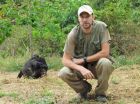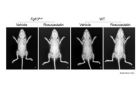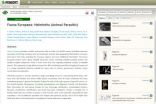(Press-News.org) The setting: Europe, about 7,500 years ago.
Agriculture was sweeping in from the Near East, bringing early farmers into contact with hunter-gatherers who had already been living in Europe for tens of thousands of years.
Genetic and archaeological research in the last 10 years has revealed that almost all present-day Europeans descend from the mixing of these two ancient populations. But it turns out that's not the full story.
Researchers at Harvard Medical School and the University of Tübingen in Germany have now documented a genetic contribution from a third ancestor: Ancient North Eurasians. This group appears to have contributed DNA to present-day Europeans as well as to the people who travelled across the Bering Strait into the Americas more than 15,000 years ago.
"Prior to this paper, the models we had for European ancestry were two-way mixtures. We show that there are three groups," said David Reich, professor of genetics at HMS and co-senior author of the study.
"This also explains the recently discovered genetic connection between Europeans and Native Americans," Reich added. "The same Ancient North Eurasian group contributed to both of them."
The research team also discovered that ancient Near Eastern farmers and their European descendants can trace much of their ancestry to a previously unknown, even older lineage called the Basal Eurasians.
The study is published Sept. 18 in Nature.
Peering into the past
To probe the ongoing mystery of Europeans' heritage and their relationships to the rest of the world, the international research team—including co-senior author Johannes Krause, professor of archaeo- and paleogenetics at the University of Tübingen and co-director of the new Max Planck Institute for History and the Sciences in Jena, Germany—collected and sequenced the DNA of more than 2,300 present-day people from around the world and of nine ancient humans from Sweden, Luxembourg and Germany.
The ancient bones came from eight hunter-gatherers who lived about 8,000 years ago, before the arrival of farming, and one farmer from about 7,000 years ago.
The researchers also incorporated into their study genetic sequences previously gathered from ancient humans of the same time period, including early farmers such as Ötzi "the Iceman."
"There was a sharp genetic transition between the hunter-gatherers and the farmers, reflecting a major movement of new people into Europe from the Near East," said Reich.
Ancient North Eurasian DNA wasn't found in either the hunter-gatherers or the early farmers, suggesting the Ancient North Eurasians arrived in the area later, he said.
"Nearly all Europeans have ancestry from all three ancestral groups," said Iosif Lazaridis, a research fellow in genetics in Reich's lab and first author of the paper. "Differences between them are due to the relative proportions of ancestry. Northern Europeans have more hunter-gatherer ancestry—up to about 50 percent in Lithuanians—and Southern Europeans have more farmer ancestry."
Lazaridis added, "The Ancient North Eurasian ancestry is proportionally the smallest component everywhere in Europe, never more than 20 percent, but we find it in nearly every European group we've studied and also in populations from the Caucasus and Near East. A profound transformation must have taken place in West Eurasia" after farming arrived.
When this research was conducted, Ancient North Eurasians were a "ghost population"—an ancient group known only through the traces it left in the DNA of present-day people. Then, in January, a separate group of archaeologists found the physical remains of two Ancient North Eurasians in Siberia. Now, said Reich, "We can study how they're related to other populations."
Room for more
The team was able to go only so far in its analysis because of the limited number of ancient DNA samples. Reich thinks there could easily be more than three ancient groups who contributed to today's European genetic profile.
He and his colleagues found that the three-way model doesn't tell the whole story for certain regions of Europe. Mediterranean groups such as the Maltese, as well as Ashkenazi Jews, had more Near East ancestry than anticipated, while far northeastern Europeans such as Finns and the Saami, as well as some northern Russians, had more East Asian ancestry in the mix.
The most surprising part of the project for Reich, however, was the discovery of the Basal Eurasians.
"This deep lineage of non-African ancestry branched off before all the other non-Africans branched off from one another," he said. "Before Australian Aborigines and New Guineans and South Indians and Native Americans and other indigenous hunter-gatherers split, they split from Basal Eurasians. This reconciled some contradictory pieces of information for us."
Next, the team wants to figure out when the Ancient North Eurasians arrived in Europe and to find ancient DNA from the Basal Eurasians.
"We are only starting to understand the complex genetic relationship of our ancestors," said co-author Krause. "Only more genetic data from ancient human remains will allow us to disentangle our prehistoric past."
"There are important open questions about how the present-day people of the world got to where they are," said Reich, who is a Howard Hughes Medical Investigator. "The traditional way geneticists study this is by analyzing present-day people, but this is very hard because present-day people reflect many layers of mixture and migration.
"Ancient DNA sequencing is a powerful technology that allows you to go back to the places and periods where important demographic events occurred," he said. "It's a great new opportunity to learn about human history."
INFORMATION:
This project was supported in part by the National Cancer Institute (HHSN26120080001E and NIH/NCI Intramural Research Program), National Institute of General Medical Sciences (GM100233 and GM40282), National Human Genome Research Institute (HG004120 and HG002385), an NIH Pioneer Award (8DP1ES022577-04), National Science Foundation (HOMINID awards BCS-1032255 and BCS-0827436 and grant OCI-1053575), Howard Hughes Medical Institute, German Research Foundation (DFG) (KR 4015/1-1), Carl-Zeiss Foundation, Baden Württemberg Foundation and the Max Planck Society.
Written by Stephanie Dutchen
New branch added to European family tree
Genetic analysis reveals present-day Europeans descended from at least 3, not 2, groups of ancient humans
2014-09-17
ELSE PRESS RELEASES FROM THIS DATE:
Natural born killers: Chimpanzee violence is an evolutionary strategy
2014-09-17
ANN ARBOR—Man's nearest relatives kill each other in order to eliminate rivals and gain better access to territory, mates, food or other resources—not because human activities have made them more aggressive.
That is the conclusion of an international analysis of lethal aggression among different groups of chimpanzees in Africa studied over five decades. The research appears in the current issue of Nature.
"Observations that chimpanzees kill members of their own species have influenced efforts to understand the evolution of human violence," said University of Michigan ...
What set the Earth's plates in motion?
2014-09-17
The mystery of what kick-started the motion of our earth's massive tectonic plates across its surface has been explained by researchers at the University of Sydney.
"Earth is the only planet in our solar system where the process of plate tectonics occurs," said Professor Patrice Rey, from the University of Sydney's School of Geosciences.
"The geological record suggests that until three billion years ago the earth's crust was immobile so what sparked this unique phenomenon has fascinated geoscientists for decades. We suggest it was triggered by the spreading of early ...
Nature of war: Chimpanzees inherently violent according to study
2014-09-17
(Chicago) -- Of all of the world's species, humans and chimpanzees are some of the only to engage in coordinated attacks on other members of their same species. Jane Goodall was among the first to introduce the occurrence of lethal inter-community killings and since then primatologists and anthropologists have long debated the concept of warfare in this genus. Research theories have pointed to increased gains and benefits of killing off competitors and opening up increased access to key resources such as food or mates. In contrast, others have argued that warfare is a result ...
Modern Europeans descended from three groups of ancestors
2014-09-17
New studies of ancient DNA are shifting scientists' ideas of how groups of people migrated across the globe and interacted with one another thousands of years ago. By comparing nine ancient genomes to those of modern humans, Howard Hughes Medical Institute (HHMI) scientists have shown that previously unrecognized groups contributed to the genetic mix now present in most modern-day Europeans.
"There are at least three major, highly differentiated populations that have contributed substantial amounts of ancestry to almost everybody that has European ancestry today," says ...
Chimpanzee lethal aggression a result of adaptation rather than human impacts
2014-09-17
In the 1970s, Jane Goodall's reports of chimpanzee violence caught the attention of a global audience. Since then, many people have compared chimpanzee intergroup aggression to primitive warfare and have argued that chimpanzee violence is an adaptive strategy that gives the perpetrators an edge. Others have argued that lethal aggression is the consequence of human activities such as provisioning (artificial feeding) by researchers or habitat destruction. A new study of the pattern of intergroup aggression in chimpanzees and their close relatives, bonobos (also called pygmy ...
Researchers use iPS cells to show statin effects on diseased bone
2014-09-17
Skeletal dysplasia is a group of rare diseases that afflict skeletal growth through abnormalities in bone and cartilage. Its onset hits at the fetal stage and is caused by genetic mutations. A mutation in the gene encoding fibroblast growth factor receptor 3 (FGFR3) has been associated with two types of skeletal dysplasia, thanatophoric dysplasia (TD), a skeletal dysplasia that cause serious respiratory problems at birth and is often lethal, and achondroplasia (ACH), which causes stunted growth and other complications throughout life. Several experimental treatments have ...
Math model designed to replace invasive kidney biopsy for lupus patients
2014-09-17
COLUMBUS, Ohio – Mathematics might be able to reduce the need for invasive biopsies in patients suffering kidney damage related to the autoimmune disease lupus.
In a new study, researchers developed a math model that can predict the progression from nephritis – kidney inflammation – to interstitial fibrosis, scarring in the kidney that current treatments cannot reverse. A kidney biopsy is the only existing way to reach a definitive diagnosis of the damage and its extent.
The model could also be used to monitor the effectiveness of experimental treatments for inflammation ...
Large study reveals new genetic variants that raise risk for prostate cancer
2014-09-17
In an analysis of genetic information among more than 87,000 men, a global team of scientists says it has found 23 new genetic variants – common differences in the genetic code -- that increase a man's risk for prostate cancer. The so-called "meta-analysis," believed to be the largest of its kind, has revealed once hidden mutations among men in a broad array of ethnic groups comprising men of European, African, Japanese and Latino ancestry.
The meta-analysis combined information from smaller studies, according to William B. Isaacs, Ph.D., a genetic scientist at the Brady ...
Babies learn words differently as they age, researcher finds
2014-09-17
COLUMBIA, Mo. – Research has shown that most 18-month-olds learn an average of two to five new words a day; however, little is known about how children process information to learn new words as they move through the preschool years. In a new study, a University of Missouri researcher has found that toddlers learn words differently as they age, and a limit exists as to how many words they can learn each day. These findings could help parents enhance their children's vocabularies and assist speech-language professionals in developing and refining interventions to help children ...
Contributions on Fauna Europaea: Data papers as innovative model on expert involvement
2014-09-17
Fauna Europaea started in 2000 as an EC-FP5 four-year project, delivering its first release in 2004. After 14 years of steady progress and successful participations in several EC projects, as a part of the EC-FP7 European Biodiversity Observation Network project (EU BON), to increase the general awareness of the work done by the contributors and to extend the general dissemination of the Fauna Europaea results, the Biodiversity Data Journal has applied its novel e-Publishing tools to prepare data papers for all 56 major taxonomic groups.
Fauna Europaea provides a public ...
LAST 30 PRESS RELEASES:
Brain stimulation device cleared for ADHD in the US is overall safe but ineffective
Scientists discover natural ‘brake’ that could stop harmful inflammation
Tougher solid electrolyte advances long-sought lithium metal batteries
Experts provide policy roadmap to reduce dementia risk
New 3D imaging system could address limitations of MRI, CT and ultrasound
First-in-human drug trial lowers high blood fats
Decades of dredging are pushing the Dutch Western Scheldt Estuary beyond its ecological limits
A view into the innermost workings of life: First scanning electron microscope with nanomanipulator inaugurated in hesse at Goethe University
Simple method can enable early detection and prevention of chronic kidney disease
S-species-stimulated deep reconstruction of ultra-homogeneous CuS nanosheets for efficient HMF electrooxidation
Mechanical and corrosion behavior of additively manufactured NiTi shape memory alloys
New discovery rewrites the rules of antigen presentation
Researchers achieve chain-length control of fatty acid biosynthesis in yeast
Water interactions in molecular sieve catalysis: Framework evolution and reaction modulation
Shark biology breakthrough: Study tracks tiger sharks to Maui mating hub
Mysterious iron ‘bar’ discovered in famous nebula
World-first tool reduces harmful engagement with AI-generated explicit images
Learning about public consensus on climate change does little to boost people’s support for action, study shows
Sylvester Cancer Tip Sheet for January 2026
The Global Ocean Ship-Based Hydrographic Investigations Program (GO-SHIP) receives the Ocean Observing Team Award
Elva Escobar Briones selected for The Oceanography Society Mentoring Award
Why a life-threatening sedative is being prescribed more often for seniors
Findings suggest that certain medications for Type 2 diabetes reduce risk of dementia
UC Riverside scientists win 2025 Buchalter Cosmology Prize
SETI Institute opens call for nominations for the 2026 Tarter Award
Novel theranostic model shows curative potential for gastric and pancreatic tumors
How beige fat keeps blood pressure in check
Fossils reveal ‘latitudinal traps’ that increased extinction risk for marine species
Review: The opportunities and risks of AI in mental health research and care
New map reveals features of Antarctic’s ice-covered landscape
[Press-News.org] New branch added to European family treeGenetic analysis reveals present-day Europeans descended from at least 3, not 2, groups of ancient humans



